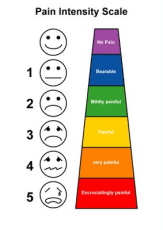Nursing Pain Scale 1-10

Nurses play such a crucial role in patient treatment and assessment. Diagnosis is an ever-present reality when dealing with patients of all types. Being able to assess pain is vitally important to the effectiveness of nursing and patient care. The best way of understanding a patient’s level of pain, is by hearing it from the patient themselves.
There are various types of pain that patients can experience. A nurse must nail down what this pain is in order to continue with assessments. The quality of the pain gives good information to the nurse and that is helpful in making a proper diagnosis. Pain quality can be described as ‘shooting pain’, ‘burning pain’, or ‘sharp or dull pain’. Only the patient can know this for certain. Once the quality or type of pain is defined, the next step is to gauge severity. This is usually done using the pain scale 1-10. When asked, the patient will rate their pain from one to ten, giving the nurse a better foundation for forming a proper diagnosis.
A useful nursing theory will make assumptions concerning health problems, environment, behaviors, and target populations, that are logical, consistent, research supported, and similar to ones that have proven to be successful in previous programs.
Once quality and severity have been nailed down, the next thing is to affix an exact location, and whether the pain came on suddenly or gradually, how long it lasts (intermittent, long, short, continuous), and if there are precipitating factors and/or things that seem to help relieve it.
Nurses then engage in the monitoring of the given signs and symptoms associated with the pain. They keep watch on the blood pressure, temperature, heart rate, ability to focus, restlessness, skin color, skin moisture, and more. All of this information will help assist the nurse in properly evaluating the pain.
Therapeutic Intervention
Nurses are highly trained and very skilled in handling pain situations. They understand that the best way of effectively dealing with pain is to prevent it altogether. Early intervention can decrease the overall amount of required analgesic. Being able to anticipate pain helps in bringing about prevention. Patients experiencing pain can sometimes have time become distorted. Nurses need to be immediately made aware of the pain. Once a complaint has been made, the nurses job is to lower the anxiety of the patient, to express concern without causing alarm. A good nurse will always be compassionate, and foster a good trusting relationship with their patients.
Nurses must also understand and recognize that certain environmental or intraphysical factors can add to the stress of a patient. They must be equipped with the type of knowledge that enables them to eliminate any additional stressors, and always be attempting to relieve the discomfort as much as possible. They must also make a determination of what pain relief methods are appropriate for each situation.
The pain scale reporting of the patient from one to ten, helps to reinforce the nurse’s diagnosis. They should match up. The nurse takes the patient’s own words, along with all other accumulated information, and forms a care plan. They create a comprehensive patient assessment to identify the cause, the location, and the proper steps to take for the alleviation of the pain. They put clearly defined goals into place, like “the patient will experience a decrease in pain within a few hours of doing such and such…”. Then an effort is made to ask the patient every hour or so to rate the pain on a scale of one to ten again, and the number should be getting lower each time. This is a measurable outcome, and reveals a care plan that is working. Meeting the established goals means a resolution of the nursing diagnosis.
Nursing Care Plans
The main purpose of a nursing care plan is to properly identify patient problems, and to then find the right solutions. There are five steps to developing this type of plan:
- Assessment
- Diagnosis
- Planning
- Intervention
- Evaluation
and all five of these need to be completed, in order to properly create a true nursing care plan. It is ill-advised to select a ‘potential nursing diagnosis’, but to take advantage of an approved priority diagnosis, that comes from NANDA (North American Nursing Diagnosis Association). The nurse will write down all assessment data and goals. For instance, if at the time of forming a diagnosis, the patient’s pain was at 8 out of 10, and the goal was to have it down to 3 at the end of the day. This would be recorded, and each successive nurse would know exactly what the goal and treatment plans were, and how to proceed.
The Nursing Profession
The nursing profession is indeed a noble one. They are everyday citizens who care about others and who are unsung heroes to many. The old stereotype of a nurse being someone who simply takes blood pressure, draws blood, and pushed someone around in a wheelchair, is so far off-base it’s laughable. They are crucial to health care in America and across the globe. Their work frees up doctors to see more patients and do what doctors do. Nursing today is highly technical, and they get quality training and develop life-saving skills. The pain scale chart from 1-10 is just one of the many weapons in their arsenal. They are driven by compassion and a true love for other people. They are unique and invaluable.
